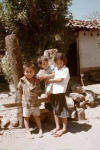welcome to worldwidewachs.com
Building a Lavandero in Nicaragua
March 10 – 24, 2001
Sometimes you transition from one world to another in what seems like an instant – you board a plane in some wintry northern city and an hour or two later alight in the sunny warmth of a southern one; you leave a high pressure meeting in a high pressure business life and drive to the lake or the mountains for a relaxing weekend with friends; you grow hot and sweaty and grimy mowing your rampant lawn or weeding your garden, then shower and dress up smartly for an evening cocktail party.
Nicaragua was not an instantaneous move to a world apart; it was a journey to another solar system. I knew this, but I didn’t really know until Nicaragua crept into me and invaded me; until I sank farther and deeper into its dusty brown hills, isolated, primitive and desperate. It was a life so far removed from any middle class North American existence that it defies imagination.
This is the true story of building a lavandero in the rural Nicaraguan community of Salale Centro; of how 12 comfortably affluent North Americans traveled separately to a place of incredible poverty, pooled their talents, energy, guts, intelligence, humor and assorted other strengths of human character to work with the Salale villagers on this ambitious project.
March 10, 2001
We’re at the Tampa airport, finally leaving the country after all these many months. The materials supplied by El Porvenir (the organization which sponsors and promotes these water sanitation projects in Nicaragua) are intriguing and stimulating, and have awakened my sense of adventure. We’re finally about to do what we retired for. It has been a very long wait.
After an uneventful flight from Tampa to Miami, and a mildly eventful flight from Miami to Managua, capital of Nicaragua, we’re greeted, along with 8 other fellow group members, by Aileen and Jeff, a young and energetic couple who are local staff members of El Porvenir. We load our assorted gear and tired bodies into the back of a scruffy pickup truck and begin the journey to our hotel. Managua is warm and sticky, 84 degrees at 9:00 pm when we drive through the festive Saturday night streets, busy with the outdoor socializing that warm weekend evenings invite. People are coming and going everywhere. In the dark it is hard to see clearly, but the houses and stores are small, tired and worn adobe/stucco structures painted in light to wild pastels. I melt back into some comfortable, soothing place in my heart that says I am right where I ought to be.
 Our hotel in Managua is La Posada Maria La Gorda, small but perfectly adequate, with clean linoleum floors, window air conditioning units, and a
multi-channel TV. (Little did we imagine how luxurious this would seem in the days to come.) During a brief orientation with Jeff, we learn we should not
put toilet paper in the toilet anywhere in Nicaragua – it should be thrown in the trash basket. After a whole
lifetime of “bathroom habits”, this is a hard one to change, especially during the more “gratifying” bathroom visits.
With only occasional relapses, Marvin and I adapt to this change quickly. In our bathroom in Maria La Gorda, there’s an upside-down quart-sized
plastic contraption dangling above the shower stall. It is clearly the key to getting hot water, but I’m baffled as to how.
I assign Marvin the task of showering first, but it turns out not to require any of his mechanical expertise, as it is a one-temperature-fits all
(tepid).
Our hotel in Managua is La Posada Maria La Gorda, small but perfectly adequate, with clean linoleum floors, window air conditioning units, and a
multi-channel TV. (Little did we imagine how luxurious this would seem in the days to come.) During a brief orientation with Jeff, we learn we should not
put toilet paper in the toilet anywhere in Nicaragua – it should be thrown in the trash basket. After a whole
lifetime of “bathroom habits”, this is a hard one to change, especially during the more “gratifying” bathroom visits.
With only occasional relapses, Marvin and I adapt to this change quickly. In our bathroom in Maria La Gorda, there’s an upside-down quart-sized
plastic contraption dangling above the shower stall. It is clearly the key to getting hot water, but I’m baffled as to how.
I assign Marvin the task of showering first, but it turns out not to require any of his mechanical expertise, as it is a one-temperature-fits all
(tepid).
We’ve been introduced to all the other members of our group except for Jose, who got on the plane to New Jersey instead of the one to Miami, and who will now be arriving several days later. After a long day of traveling, we exchange wilted goodnights in the un-airconditioned interior patio, and trudge off to our rooms, hoping for a good night’s sleep.
March 11, 2001
The day begins with a knock on our door at 6:00 am, and breakfast in the interior patio, warm, muggy and breezeless, at 7:00. After breakfast, we load all our suitcases and backpacks into the truck, then climb aboard a small bus for the 4-hour trip to El Sauce (pronounced el sow-say), a town of about 3000 that will be our base of operations.
The bus is an embattled veteran of Nicaraguan highways, with seats reminiscent of the comfort of a school bus, and an air conditioning system that consists of sliding glass windows which require serious power lifters to operate. Our journey takes us through the bustling streets of Managua, emerging onto a major paved highway lined with adobe and brick huts, people traveling on foot, horseback and bicycle, children playing, thin, gangly cows grazing on scrubby, dry grasses and shrubs, and occasionally wandering on the road. We pass Lake Managua and Mumo-Tumbo volcano. There are several other volcanoes, misty and faded in the distance, but I don’t learn their names.
After several hours, we turn on to a narrower, but still paved highway. The last hour or more is a dusty dirt road. They are constructing a “cement brick” road here, but the construction is occasional, and most of the driving must be on the wobbly, rutted edges and side trails. We creep along, negotiating large holes and obstructing rocks. When we slow to traverse these items, the breeze catches all the dust we’ve created and blows it back through the bus. We all begin to breathe dust, taste it, feel it settle across our arms and legs in a fine tan layer. Everything about us begins to seem muted, as in a dusty, filmy, sepia photograph.
The houses are no more than huts, adobe and thatch, occasionally brick. They range from 200 – 400 square feet, tired and crumbling structures with open windows and doors, and dirt floors. Most have small latrine houses nearby. Chickens and pigs and occasionally goats roam freely around the “yards”. When we are almost to El Sauce, we pass a community of sherbet-colored houses – small square blocks of pastels in mint green, strawberry and pineapple with matching latrine houses. We learn these have been built by the government to relocate families who lost their homes during Hurricane Mitch (in 1998).
Our bus pulls up to a corner building, and as the swirling dirt settles all around us, we unfold our sweaty bodies out of the seats and tumble onto the dusty sidewalk. The temperature must be in the 90’s, and the sun is boring down in its mid-afternoon glory.
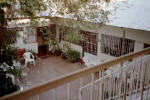 Our hotel is called Casa Blanca, and it is brand new. So new there is no ceiling in our bathroom – you can see
all the way to the tin roof, and could even climb over the top of the bathroom wall to the room next door. Marvin
and I are on the second floor, in a room about 10 by 10, with light cream cement walls, a wooden
floor and one louvered window in the corner with no screen. There is a 4” foam mattress on a wooden frame (hard, but at least not
lumpy) and one set of unmatching plaid and flowered sheets. The only other furniture (there isn’t room for anything else anyway) is a pair of
wooden open nightstands on each side of the bed. The saving grace is a wall fan, which hums back and forth as it surveys
the room. Everything is simple, basic – a clean $25 a night room in the U.S., and compared to what living
accommodations we’ve seen along the way, this is heaven.
Our hotel is called Casa Blanca, and it is brand new. So new there is no ceiling in our bathroom – you can see
all the way to the tin roof, and could even climb over the top of the bathroom wall to the room next door. Marvin
and I are on the second floor, in a room about 10 by 10, with light cream cement walls, a wooden
floor and one louvered window in the corner with no screen. There is a 4” foam mattress on a wooden frame (hard, but at least not
lumpy) and one set of unmatching plaid and flowered sheets. The only other furniture (there isn’t room for anything else anyway) is a pair of
wooden open nightstands on each side of the bed. The saving grace is a wall fan, which hums back and forth as it surveys
the room. Everything is simple, basic – a clean $25 a night room in the U.S., and compared to what living
accommodations we’ve seen along the way, this is heaven.
After lunch of beans, rice, mashed potatoes, carrots, chayote (squash) and a jaw-exercising mystery meat for the non-vegetarians, we gather in the inner courtyard for an orientation. In a heat so intense every part of my body sticks to itself, we learn about Nicaraguan customs and cultural dos and don’ts, a few key Nicaraguan Spanish words, some health and safety rules, and the mission of El Porvenir. El Porvenir means “the future” in Spanish, and the organization is an offshoot of Habitat for Humanity’s housing projects in Nicaragua. El Porvenir’s goal is to enable poor people in Nicaragua to improve their standard of living and health through sustainable self-help water, sanitation and reforestation projects.
Jeff and Aileen have been working for El Porvenir in this geographic area for about 18 months. They are bright, engaging, knowledgeable, enthusiastic and dedicated. We learn a little about the lavandero (a facility with 4 laundry washing stations and 2 bathing cubicles) we will build, and the community of Salale Centro, where we will build it.
There are some important safety-health rules. Don’t drink any water that isn’t from the jugs provided by El Porvenir, or otherwise OK’d by Jeff and Aileen. Drink water constantly, or you’ll become dehydrated in this heat. Don’t make certain typical American hand gestures, because they mean something else here in Nicaragua. And so on……
We learn more about our fellow group members. We’re an eclectic, interesting, seasoned group of travelers, all 11 (Jose has still not arrived). There are 5 women (Celia, Carolyn, Patty, Wahana and me), and 6 men (Ceasar, Fred, Homer, Jim from Maine, Jim from New York, and Marvin). As a group we’ve been to every continent, and our experiences are varied. We all, however, have our own personal and compelling reasons for coming to Nicaragua – among them a love for people, especially struggling ones wherever they are, and for many of us, a special affinity for Central and South America.
Jeff and Aileen ask us to share the reasons that brought us here. I confide that my insistent wanderlust caused me to abandon a great career, and Marvin relates that, after all the years I followed him and “lived his life”, he is now following me and “living mine”. Celia says she’s here because we Americans take so much of the world’s resources that she believes we owe it to the world to give something back. I’ve never thought of it quite that way, but it sounds right to me.
March 12, 2001
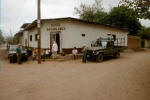 This morning we finally get to start working on the lavandero. Last night I listened to Marvin snoring himself through a decent
night’s sleep, while I lay perspiring, suspended between dreams and wakefulness most of
the night. The hovering heat and the sounds of El Sauce encircled me, the confused roosters crowing at various hours of the night, a late night pig
butchering in the yard right next door, the magnified reverberations of the birds taking an early morning constitutional on the tin roof, and all
the other comings and goings of the hotel and the town. Finally, at around 4:00 am, it was cool enough to pull the sheet over us
and drift into a trance resembling sleep.
This morning we finally get to start working on the lavandero. Last night I listened to Marvin snoring himself through a decent
night’s sleep, while I lay perspiring, suspended between dreams and wakefulness most of
the night. The hovering heat and the sounds of El Sauce encircled me, the confused roosters crowing at various hours of the night, a late night pig
butchering in the yard right next door, the magnified reverberations of the birds taking an early morning constitutional on the tin roof, and all
the other comings and goings of the hotel and the town. Finally, at around 4:00 am, it was cool enough to pull the sheet over us
and drift into a trance resembling sleep.
After a 6:30 breakfast (scrambled eggs, dry toast and papaya), we climb aboard our two pickup trucks and bump down the dusty road to Salale. It is 25 minutes of bone-jarring dirt roads, through dusty brown hills, past adobe shacks and men on horseback and more wandering cows, to get to Salale.
Salale is a town of several hundred people – there are several dozen adobe houses, and one main dirt road into the village. This town has no electricity. Its water source was developed by El Porvenir in previous projects, and there are several community water spigots scattered throughout the town. There are no cars, no yards, no grass – only the same dirt and rocks for the street as everywhere else.
The entire town must be here to welcome us. As we tumble out of the trucks, there are 2 dozen or so men, another dozen teenaged boys, a smattering of women and teenaged girls, and swarms of small wriggling children. We meet Efraim, the community leader of the lavandero project, and Pablo, the jefe or foreman, hired to provide the construction expertise.
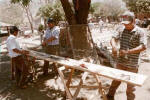 After introductions and exchanges of warm welcomes, we start divvying up projects and scatter to our tasks. Many of the
men choose to begin digging a French drain about 6 feet in diameter and 9 feet deep; several
of our group begin bending and tying rebar; others start digging postholes. There are several festive pickup truck trips to the creek, to gather
rocks of various sizes and haul them back to the construction site. Every trip to the creek is joined by scores of chattering, excited
children, even the 4 and 5 year olds hauling hefty rocks and contributing to the cause.
After introductions and exchanges of warm welcomes, we start divvying up projects and scatter to our tasks. Many of the
men choose to begin digging a French drain about 6 feet in diameter and 9 feet deep; several
of our group begin bending and tying rebar; others start digging postholes. There are several festive pickup truck trips to the creek, to gather
rocks of various sizes and haul them back to the construction site. Every trip to the creek is joined by scores of chattering, excited
children, even the 4 and 5 year olds hauling hefty rocks and contributing to the cause.
All morning we slog away in the brutal heat, surrounded with the enthusiasm and hard work of the entire village. After 4 sweaty, hot, draining hours, and what appears to be only minimal progress, Jeff and Aileen pronounce us finished for the day, and we haul our weary bodies back on the truck for the return trip to El Sauce.
There is no time before lunch at Casa Blanca for cleaning up, so we eat in our filthy work clothes. Anyway, the water and the electricity here are not completely reliable, especially the water. Water pressure on the second floor is minimal to nil if anyone on the first floor is showering, but if you wait in the shower stall for a few minutes, you can usually find it restored. There is no hot water – only cold – but the weather is so hot that cold water showers are a relief and a blessing.
After lunch and showers, we have some free time. Marvin falls asleep on the bed. I reach for his thermometer and it reads 96 degrees in our room. The lifesaving fan whirs blissfully while I try not to exert even a smidgeon of heat-producing energy.
In the late afternoon, we gather in the courtyard for a group walk to the primary school in El Sauce, where an elementary school principal named Hugo gives a very informative 2-hour lecture (and Q and A session) on the culture, politics, education system, living conditions and work opportunities in Nicaragua, and especially in the local area. We learn that the average home is only 3 rooms, that before Hurricane Mitch there was a deficit of some 700 homes in this area, but more than 200 more homes were destroyed in the hurricane, so the housing shortage is now even worse. Although the government has built new housing in areas like the sherbet-colored developments we saw yesterday, these homes cost $40 per month to buy, and this is so unaffordable that most of these developments stand empty.
Unemployment in the El Sauce area is about 50%. Education is not compulsory. And in the centuries old struggles for political top dog among the most powerful (in which even the U. S. government shamefully inserted itself), the campesinos, the rural people who are part of the backbone of Nicaragua, have been ignored and forgotten. There are precious few resources in this struggling country, and far too many of them have been diverted for the pleasures of a powerful few at the top.
Besides the hotel, there is only one other place to eat in El Sauce, and at 6:30, in the gathering darkness and resultant coolness of twilight, our group trudges off down the dirt street and around the corner to Mi Rancho for dinner. We have rice and beans and French fries, and some more mystery beef for the meat-eaters. I am so queasy and lethargic from the heat that I nibble on a few beans and French fries, concentrating on the pitcher of cold water that Jeff and Aileen have assured me is bottled and purified.
Later, lying absolutely still in our beds at the hotel, just before we drop off to sleep, I sneak a peek at the thermometer, and am amazed it has dropped all the way to 90. The blessed fan whirs industriously, and a restful sleep settles over me like a heavy fog.
March 13, 2001
Up again at 6:00, with breakfast of beans and rice, fried platano (a kind of banana) and some salty, coarse cheese. There is also a plate of papayas and bananas, and some unbuttered toast. It is already 85 degrees, and although I am refreshed from a good night’s sleep, I can barely stuff down a few slices of banana and some toast.
Today a group of us start out in a brick brigade, a line of 15 or 20 group members and villagers moving the bricks from a pile on one side of the road to a spot nearer the lavandero-to-be. Several delighted children are scattered among us, passing the bricks just as dutifully and more joyfully than the adults. They are so pleased to be a part of one of the most exciting events ever in this little village. Jeff and Aileen have assured us that the people of Salale have been talking about the lavandero project and the Americans for months, and that this will continue to be the subject of discussion in the village for many years to come.
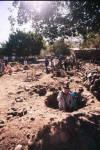 Marvin and several other
group members return to work on the rebar, and Jim from Maine stays faithful to his project of yesterday – the huge French drain.
I help Jeff install the pump on the existing well, then join a group digging a ditch from the well toward the lavandero – about 40 feet
across the central dirt intersection of the town.
Marvin and several other
group members return to work on the rebar, and Jim from Maine stays faithful to his project of yesterday – the huge French drain.
I help Jeff install the pump on the existing well, then join a group digging a ditch from the well toward the lavandero – about 40 feet
across the central dirt intersection of the town.
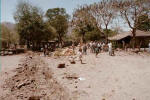 It is the end of the dry season in Nicaragua, and the whole world has faded to a dusty brown haze. Every instrument that strikes
the earth as we dig this ditch sends up a rising brown cloud that is caught and scattered by the wind.
Our sweat merges with the dust and we take on the rich brown coloring of the locals. My skills with a pickax
are obviously a source of great amusement to Jorge (an 18-year-old villager I’ve met) and his friends, who are smiling and laughing constantly as
I battle with this rockiest of soils. After about 10 minutes of being the village idiot, I graciously offer to exchange
tools with Jorge – he taking the pickax, and I taking his shovel. It wasn’t nearly so much fun for Jorge and his friends after that, but
I must report that we made much faster progress.
It is the end of the dry season in Nicaragua, and the whole world has faded to a dusty brown haze. Every instrument that strikes
the earth as we dig this ditch sends up a rising brown cloud that is caught and scattered by the wind.
Our sweat merges with the dust and we take on the rich brown coloring of the locals. My skills with a pickax
are obviously a source of great amusement to Jorge (an 18-year-old villager I’ve met) and his friends, who are smiling and laughing constantly as
I battle with this rockiest of soils. After about 10 minutes of being the village idiot, I graciously offer to exchange
tools with Jorge – he taking the pickax, and I taking his shovel. It wasn’t nearly so much fun for Jorge and his friends after that, but
I must report that we made much faster progress.
The ditch digging took up most of the rest of the morning. We excavated dozens of rocks a foot or more in diameter and a few twice that size. Since there is apparently no litter campaign in Salale, we also excavated such anthropological treasures as shoe parts, plastic bags, ropes, bottle tops, and assorted otherhousehold items.
In the late morning, during a lull in the digging, a group of teenaged girls crowds around me and asks curious questions – am I married, do I have children, aren’t I worried about getting sunburned, where do I live, what do I think of Nicaragua. When they learn that Marvin is my husband, they pronounce him guapo (handsome), and I’ve decided to add this title to my private list of endearing terms for him.
Today we have lunch in a house in the village. Three local women have cooked for us and they serve plates of beans and rice, fried cheese, squash and fried platano. The food is good, but they have gone overboard in sanitizing the fruit drink, and the resulting juice is a stomach-churning essence of Clorox with a mild fruity aftertaste. My intestines complain for the rest of the afternoon.
After lunch, we go to the health clinic at the edge of town to learn about the health care system from the two nurses who work there. The clinic is a 4-room brick building serving Salale Centro and the surrounding communities. Out group elects to sit in the cooler shade and breeze outside the clinic while we have our session. We learn that the head nurse has 1 ½ years of post high school education, and earns about $200 month after 10 years of service. The most common health problems they see are respiratory illnesses, diarrhea and fevers. But the help they can offer is limited, because government-provided medicines are only delivered once every 2 months, and supplies are usually gone within a few days after the delivery. The serious medical problems that can’t be handled in this small clinic are referred to El Sauce, but emergencies must wait for the twice-a-day bus service, as there is no other form of transportation.
We’re back in El Sauce and at the hotel by around 3:00, and we head immediately for the showers. Marvin gets enough water to finish his shower, but there is nothing left by my turn. I wait, relatively patiently for me, and am eventually rewarded.
Around 5:00, just as the sun is losing its fierceness, Marvin and I stroll around El Sauce. The streets are
dirt, with occasional rocky strips where there is any incline, to preserve the street during the rainy season. The houses front
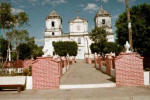
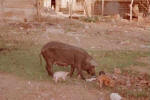 directly on the street, and through the open doors, we can see dirt floors
and sparse furniture – a few wooden chairs, a table, and occasionally a TV.
Residents are starting to bring their chairs out into the street, where
they can catch the evening breeze and visit with neighbors.
A sow and four weeks-old piglets are grazing in a field at the edge of
town, some men and a few teenagers ride by on sturdy old bicycles, school
children in uniforms are drifting along, chattering and mingling, still carrying
their books, and some young men are playing
basketball at the plaza near the cathedral.
directly on the street, and through the open doors, we can see dirt floors
and sparse furniture – a few wooden chairs, a table, and occasionally a TV.
Residents are starting to bring their chairs out into the street, where
they can catch the evening breeze and visit with neighbors.
A sow and four weeks-old piglets are grazing in a field at the edge of
town, some men and a few teenagers ride by on sturdy old bicycles, school
children in uniforms are drifting along, chattering and mingling, still carrying
their books, and some young men are playing
basketball at the plaza near the cathedral.
Dinner is rice, potatoes, fried bananas, cheese and squash, with an added beef dish for meat-eaters. I can manage to swallow only the boiled potatoes. I have fantasies of being caught in a snowstorm and making a snowman, drinking ice cold water, and taking a teeth-chattering bath in ice cubes.
March 14, 2001
It was close, but Marvin and I lost our valiant struggle last night to stay awake until 10:00. We report for breakfast refreshed and ready. I have an idea – I’ll only report what we have for meals in addition to the rice and beans! That should shorten this journal considerably. Add scrambled eggs and toast to the menu for this morning.
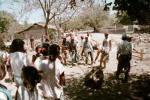 In Salale Centro today, we finish the ditch, lay the pipe from the well to the lavandero, pour concrete around the
pipe, fill the ditch back up with dirt (sifting carefully through the rocky soil we’ve dug out to remove any of the stones that could damage the pipe),
then use a pole with a heavy round flat end to stamp down the area. The French drain diggers are now 6 feet down and using a bucket pulley
system to haul out the dirt. They’ve extracted several huge rocks, to the applause and cheers of all onlookers.
Marvin helps Jeff put in the wet end of the pump.
In Salale Centro today, we finish the ditch, lay the pipe from the well to the lavandero, pour concrete around the
pipe, fill the ditch back up with dirt (sifting carefully through the rocky soil we’ve dug out to remove any of the stones that could damage the pipe),
then use a pole with a heavy round flat end to stamp down the area. The French drain diggers are now 6 feet down and using a bucket pulley
system to haul out the dirt. They’ve extracted several huge rocks, to the applause and cheers of all onlookers.
Marvin helps Jeff put in the wet end of the pump.
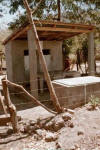 During a lull in the work, Marvin and I hike up to Salale Montana, a smaller town about a mile away, to see their finished and installed lavandero.
It’s helpful to see the finished product, to visualize and better understand how all our separate little work tasks will ultimately come together.
During a lull in the work, Marvin and I hike up to Salale Montana, a smaller town about a mile away, to see their finished and installed lavandero.
It’s helpful to see the finished product, to visualize and better understand how all our separate little work tasks will ultimately come together.
After lunch at Casa Blanca, our group receives the laundry we’ve sent out the day before. Jeff and Aileen have cautioned us to send only the sturdiest of items that can withstand repeated rock scrubbings, but all clothes come back still intact, and remarkably cleaner, given the washing methods they had to use.
At 2:45 pm we walk as a group in the 95 degree heat to the central plaza, where we have an appointment to meet with the mayor. After a short wait, we file into a large high ceiling room, and pull up chairs around a long wooden table. There is a ceiling fan providing the barest of breezes in the windowless room, that also serves as the town library – one wall contains the entire neatly categorized collection of perhaps 200 volumes. The mayor, an attractive, 40ish woman, answers our questions about the election process, and the major problems and initiatives facing the municipality. With high rates of unemployment, lack of housing, poor nutrition, and minimal educational and health facilities, this job is anyone’s nightmare. There is no money to improve these problems, because no one can afford to pay taxes. But the mayor is the wife of the former mayor, so she knows clearly what she is up against, and she appears completely unruffled by such staggering problems and incredible odds. We are overcome with the complexity of this job, and in awe of her indomitable spirit and energy.
For dinner at Mi Rancho, the vegetarians have noodle soup to go with our standard fare of …..(you know what). The meat eaters choose from the usual array of tough steak or chicken. Every lunch and dinner we have a refresca, a fruit juice of one of the local fruits – papaya, tangerine, some really seedy yellowish fruit that starts with a “g”, and other exotic items. Tonight was papaya, and it hit the spot.
March 15, 2001
Our first casualty of the Nicaraguan diet/health regime was Carolyn, who had to decline joining the work group yesterday in favor of proximity to bathroom facilities. This morning we also lose Ceasar to the same cause.
At the worksite, we stamp down the earth around the ditch some more, then begin laying bricks at the bathing end of the lavandero building. Jose has finally arrived via his detour to New Jersey, and, being native Nicaraguan and a raging extrovert to boot, immediately becomes the darling of the entire town of Salale Centro. He buddies up with the bricklayer, and I feed Jose properly wetted and sized bricks, which he delivers to the bricklayer. Some of our group help put a barbed wire fence around the well, and others begin filling in the French drain with large and small rocks alternately. Between the rocks from the river and the rocks we’ve dug out of various holes, we have more rocks than I’ve ever seen in my life. If rocks were a precious commodity, Nicaragua would be the richest country in the world!
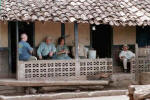 We have lunch at the house in Salale Centro again - the usual. I pass on the fruit drink today. The
resident pig, having been disturbed from his nap on the porch, and perhaps
sensing an opportunity for a grander than usual meal, wanders through the dining
area, into the kitchen and out into his normal feeding area in the backyard.
Several neighborhood dogs saunter in and out, as do a few of the curious
children.
We have lunch at the house in Salale Centro again - the usual. I pass on the fruit drink today. The
resident pig, having been disturbed from his nap on the porch, and perhaps
sensing an opportunity for a grander than usual meal, wanders through the dining
area, into the kitchen and out into his normal feeding area in the backyard.
Several neighborhood dogs saunter in and out, as do a few of the curious
children.
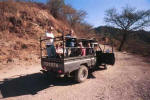 After lunch, we pile into the pickup truck for a short “ride” to Salale La Montanita. The road crosses the river,
then winds treacherously up the mountain, and the truck needs every tread on its tires and every horsepower in its arsenal to climb over the rocks
and gullies that twist us sideways and bounce us heavily as we go. The one-room school in Salale La Montanita is our destination.
It is built of the same coarse brick our lavandero is being built with – with walls up to about 5 feet, and open air above that to about
an 8 foot slanted tin roof ceiling.
After lunch, we pile into the pickup truck for a short “ride” to Salale La Montanita. The road crosses the river,
then winds treacherously up the mountain, and the truck needs every tread on its tires and every horsepower in its arsenal to climb over the rocks
and gullies that twist us sideways and bounce us heavily as we go. The one-room school in Salale La Montanita is our destination.
It is built of the same coarse brick our lavandero is being built with – with walls up to about 5 feet, and open air above that to about
an 8 foot slanted tin roof ceiling.
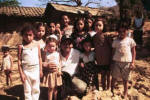 The young male teacher, who earns about $100 per month, describes his curriculum and teaching challenges– 28 students this year and only 18 desks,
and some of the 18 desks are already broken or damaged. He teaches students ages 6 through 12, “levels” 1 through 3. He would also
teach level 4, if there were students needing it. Students who want levels 5 and 6 must go to Salale Centro. There are not
enough textbooks, so he has asked the government for additional ones, and has been told h may receive them by the end of the school year. The very few
students who wish education past level 6 must find a way to get to El Sauce, and this is a nearly impossible feat, both logistically and financially.
The young male teacher, who earns about $100 per month, describes his curriculum and teaching challenges– 28 students this year and only 18 desks,
and some of the 18 desks are already broken or damaged. He teaches students ages 6 through 12, “levels” 1 through 3. He would also
teach level 4, if there were students needing it. Students who want levels 5 and 6 must go to Salale Centro. There are not
enough textbooks, so he has asked the government for additional ones, and has been told h may receive them by the end of the school year. The very few
students who wish education past level 6 must find a way to get to El Sauce, and this is a nearly impossible feat, both logistically and financially.
This year, the parents in the Salale area have joined together to pay for a teacher for the first year of high school at the Salale school, hoping they can demonstrate enough of a need so the Ministry of Education will take over the payment of the teacher next year. But some of the students are dropping out, needing to help with farming, or other chores, and the remaining students’ parents are now stuck with a heavier share of the teacher’s salary. There is speculation there may not be enough money for the teacher to finish the year.
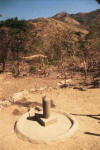 After
the session in the school, Marvin and I and a few others follow Jeff farther up the hill to see the gravity water system the community recently
installed so they could have a source of water. This project involved manually digging over 3 kilometers of ditch all the way across
the next mountain to an artesian well. It is truly an impressive job.
After
the session in the school, Marvin and I and a few others follow Jeff farther up the hill to see the gravity water system the community recently
installed so they could have a source of water. This project involved manually digging over 3 kilometers of ditch all the way across
the next mountain to an artesian well. It is truly an impressive job.
Back to the hotel, and cold showers to chase away the dirt and mitigate the heat. If I lie very still on the bed and don’t let any of my body parts touch any other body parts, I can maintain the illusion of not sweating for at least 5 minutes.
After dinner at Casa Blanca, we have a fancifully decorated chocolate cake that I haveordered through the hotel proprietors. We hadn’t had any dessert for days, and I felt the need to take precautionary steps, lest my chocoholic tendencies raged out of control. So we feast on large gooey portions, messy and completely, splendidly delicious.
We’ve another casualty tonight. Celia is sick, probably suffering from a combination of diabetic insulin imbalance and heat exhaustion. Jeff and Aileen get a doctor to check on her, and offer her plenty of rehydrating solutions from their first aid arsenal.
March 16, 2001
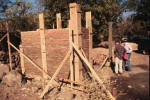 Carolyn joins the living today, while Ceasar and Celia and Fred are casualties for various reasons and beg
out of work today. It is a slow day anyway – we pile rocks at the bottom of the barbed wire fence around the well,
so the chickens will not be able to get in. Jeff takes the rest of the group up the hill to see the completed lavandero,
but since Marvin and I saw it the other day, we stay in Salale and continue working. I help the bricklayer on
the second wall of the bathing rooms.
Carolyn joins the living today, while Ceasar and Celia and Fred are casualties for various reasons and beg
out of work today. It is a slow day anyway – we pile rocks at the bottom of the barbed wire fence around the well,
so the chickens will not be able to get in. Jeff takes the rest of the group up the hill to see the completed lavandero,
but since Marvin and I saw it the other day, we stay in Salale and continue working. I help the bricklayer on
the second wall of the bathing rooms.
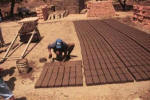
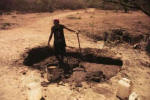 We leave the worksite early and go down the road to the brick “factory”. We’re in luck – the 2 employees are making bricks today. Man #1 is
shoveling gobs of black ooze into a shallow pit, then stamping around in it with his bare feet – like you would imagine stamping grapes, only much
slimier. This man tells us they dig the dirt from an area farther up the mountain, where the soil is just the right consistency, then bring it to
this field for preparing. Man #2 has a wooden mold with 7 brick holes in it and is filling the mold with the prepared mixture.
Then he lays the bricks out on the ground to bake in the sun for a week. After that, they load them in the wood-fired oven built into the adjacent
hill, to bake. It is a simple, but smooth operation.
We leave the worksite early and go down the road to the brick “factory”. We’re in luck – the 2 employees are making bricks today. Man #1 is
shoveling gobs of black ooze into a shallow pit, then stamping around in it with his bare feet – like you would imagine stamping grapes, only much
slimier. This man tells us they dig the dirt from an area farther up the mountain, where the soil is just the right consistency, then bring it to
this field for preparing. Man #2 has a wooden mold with 7 brick holes in it and is filling the mold with the prepared mixture.
Then he lays the bricks out on the ground to bake in the sun for a week. After that, they load them in the wood-fired oven built into the adjacent
hill, to bake. It is a simple, but smooth operation.
Marvin and I have discovered two other people – Carolyn and Jim from Maine - who are as enamored with bridge as we are, and we’ve gathered in the courtyard several afternoons to play. Carolyn and Jim are better players than we are, and have been casually reducing us to an extremely humble state. This afternoon, we bring out two new horseshoes we’ve borrowed from a man in Salale, and our luck and playing improve marginally. Carolyn and Jim are still way ahead of us.
It seems hotter and muggier today, if that is possible. There is less wind than usual, and perhaps that makes it just seem hotter. Breakfast, lunch and dinner continue to be a variation of rice, beans, eggs and squash.
In the late afternoon, we meet with the head of the women’s center in El Sauce. We learn that few Nicaraguans bother getting married, and that few Nicaraguan women have husbands who support them and their children. Currently, the center has no place of operation because the house they’ve used for years has been taken over by a family who claims title to it. The matter is being debated in the courts, but the women’s center doesn’t have enough money to pay their lawyer.
March 17, 2001
It is Saturday morning. There is no water for bathing this morning, as there was none yesterday morning either. But we’re off to the worksite for a morning’s work before we take a day off and head to the beach.
We expect this morning’s work to be slow too, but it is delightfully busy. Jeff asks several of us to clean up the central area between the well and the lavandero – pick up the rocks and trash and smooth out the dirt. I find it curiously amusing to be “cleaning up” an area that is all rocks and dirt, and I’m smiling to myself as we work along. This is kind of like being small children again, digging and playing in the sandbox, sifting dirt and rocks and looking for treasures.
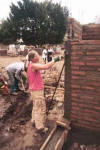 After that, I spend the rest of the morning with a hatchet-like instrument, chipping
excess cement off the poured columns of the lavandero, in preparation for
applying stucco to the outside walls. Other
group members work on several other columns, re-laying brick on one of the
walls, digging a ditch from the water pipe closer to the lavandero, and
mixing and pouring more concrete.
After that, I spend the rest of the morning with a hatchet-like instrument, chipping
excess cement off the poured columns of the lavandero, in preparation for
applying stucco to the outside walls. Other
group members work on several other columns, re-laying brick on one of the
walls, digging a ditch from the water pipe closer to the lavandero, and
mixing and pouring more concrete.
We quit working early and head back to El Sauce for lunch. It is a delicious surprise of paella – rice in a tomato sauce with carrots and squash, olives, raisins, peas and chicken for the meat-eaters. Then we rush through showers and packing, and load onto our sturdy bus by 1:00.
The first few miles out of El Sauce are on a paved road, but the pavement is so rutted and potholed that we drive on the dirt shoulder where it is smoother. After that comes the same dusty road we took to get here last week, but it seems even worse than I remembered. The dust clouds invade every crack in the windows and doors – settling in our eyes, throat, arms, legs, hair, eyebrows and every layer of clothing. There are brown streaks on my thighs where I’ve sweated, and fine, gritty particles on my lips and teeth. It’s like saving all the dust from a full vacuum cleaner bag, dumping it into a grocery sack, pulling the sack over your head and rotating it every minute.
It is a 5-hour drive, through the countryside and several small and large cities, to Las Penitas, our hotel on the Pacific Ocean. The outside of the hotel is orange stucco, trimmed in blue – giving a true holiday effect. Our room here is larger than at Casa Blanca, but dirty and smudgy all around the edges, with a dank, moldy smell. You have to pass by the toilet to get to the shower, but there is only a 5 inch gap, so it’s pretty tight. When you sit on the toilet, it must be sideways, choosing between putting your feet in front of the sink or into the shower. If you choose the easier sink option, you must do a reverse Houdini twist while executing a right-handed backstroke to retrieve the toilet paper from the wall behind you. The shower head trickles most of the water against the wall, so you have to do a Letterman Velcro body-stick against the wall to bathe yourself.
Buthey – we’re at the ocean! Our room opens to a hallway - balcony, from which we can view the Pacific surf, and there’s a delightful, playful breeze enticing us to the beach. Marvin and I quickly change into our bathing suits and go for a walk, followed by a brief romp in the surf. Most of our other group members do the same.
We have cocktails on the patio restaurant overlooking the ocean and watch the sun set. It is a beautiful view, and a delightfully refreshing evening, and we feel festive and playful, having a wonderful break from the past week’s routine. For dinner on the patio we have..... well, never mind.
March 18, 2001
It was a restless night. The fan in our room had 3 speeds, but speeds 1 and 2 were imperceptible, and speed 3 was just barely a whisper. A foot from the ceiling on the hall side and the side bordering another room is some concrete grillwork, through which the outside air flows freely. At 4:00 in the morning, someone entered the room next door and turned on the light, rummaging around as though hunting for something. Through the connecting grillwork opening, the light from next door shone through and made like a wake-up call.
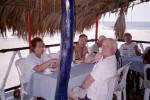 Yesterday, one of our group members, Jim from Maine, slipped in the bathroom and tore the sink off the wall as he fell. He
cut his thumb badly. He doesn’t get to swim in the ocean today.
Yesterday, one of our group members, Jim from Maine, slipped in the bathroom and tore the sink off the wall as he fell. He
cut his thumb badly. He doesn’t get to swim in the ocean today.
We have free time after breakfast, and Marvin and I choose to walk the beach in the opposite direction from yesterday. The volcanic sand is fine and soft, with very few shells. It ranges in color from dark taupe to semi-sweet chocolate. We walk for a little over an hour, then play in the surf in front of the hotel for a while longer. When we return, Celia and Wahana (who live in California and whom I therefore consider experts) report we’ve just had an earthquake. They were in their rooms when their water glasses started jiggling. Fred confirms this happened to him too. We’re skeptical, but a day or two later we confirm from reading the paper that there was a 4.4 earthquake at just that time in a city nearby.
We all left the states the day before the NCAA basketball tournament teams were announced, and Jim has been trying ever since to find out which teams made the cut. The newspaper in El Sauce and the TV in the lobby at Casa Blanca (both in Spanish) have been silent on this issue. There’s a TV in the lobby at our beach hotel, and Jim hopefully tries it, but it has nothing but black and white fuzz. We have no radio, and the only phone in El Sauce is a several block walk away – and good luck getting through in Spanish! We are as isolated from the worlds we all used to live in as we can imagine.
After lunch, we load up our gear and ride the bus back to El Sauce. We stop briefly in Leon to view a beautifully painted historical mural in a downtown park, and the largest cathedral in Central America, on the adjoining square. Then another 2 hours on the same dusty road back to Casa Blanca, our “home” in El Sauce. There is no water pressure, so we have dinner in an unbathed state. There is a mandarin orange refresca tonight – my favorite drink yet.
Back in our hotel room, it is a sweltering 94 degrees at 9:00. But the water is back on, so we shower, then lie on the bed with wet washcloths and wipe our arms and necks periodically, letting the fan breeze cool us lightly.
March 19, 2001
Last night we were again auditory witnesses to the fierce and valiant struggle of a pig about to be slaughtered next door. After that was over, everything else seemed comparatively quiet, and we slept well.
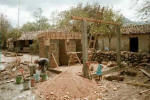 This morning, for the first time since we’ve been here, there are serious gray clouds, and the air even smells of rain. We head out to our
worksite at the usual time, and see the villagers have made good progress while we’ve been gone. After a short
time piling up sand for the cement, I climb on the truck with Aileen and 4-5 village men to ride out of town a short distance and dig fill dirt.
We make several trips, filling the back of the pickup truck each time, and this takes most of the morning. The clouds are a welcome relief, and we even
have intermittent drizzle.
This morning, for the first time since we’ve been here, there are serious gray clouds, and the air even smells of rain. We head out to our
worksite at the usual time, and see the villagers have made good progress while we’ve been gone. After a short
time piling up sand for the cement, I climb on the truck with Aileen and 4-5 village men to ride out of town a short distance and dig fill dirt.
We make several trips, filling the back of the pickup truck each time, and this takes most of the morning. The clouds are a welcome relief, and we even
have intermittent drizzle.
After lunch at Salale, just as we are about to load up on the truck and leave, the villagers are gathering and talking and clearly disturbed about something. Suddenly, we learn a man named Carlos has been attacked by his “crazy” brother with a machete. Soon Carlos is led out into the central area, one of his arms being held above his head, blood trickling down his face, and his chest and shoulder area completely soaked with blood. Jim from Maine is a former fire chief and trained EMT, and he goes with Jeff to check on Carlos. The injuries are pretty serious and he is losing a lot of blood. This is not a case for the local health clinic, so Jeff and Jim and Jorge load him in the back of one of the pickups and drive quickly to El Sauce. There is concern about where the “crazy” brother has gone, but we are assured he has fled. The rest of us crowd into the one remaining truck and ride back to El Sauce too.
We have the rest of the afternoon free, and we hang around the hotel, or take walks around El Sauce. There are several rain showers, and although it is still hot and humid, the moisture keeps the dust down in the streets. Later in the afternoon, Jeff returns and reports that Carlos has been taken to the hospital in Leon, where he will have surgery to repair the tendons in his arm. Jeff is worried that our group might have found the attack so traumatizing that we will not want to return to Salale in the morning, but we assure him we have no intention of staying away. Tomorrow is the last work day, and the afternoon will be a celebration with the villagers. The lavandero will likely not be finished until a little later in the week, but it is well on schedule, and since our group will be leaving, the party will be tomorrow.
March 20, 2001
It rained hard during the night – almost deafening on the tin roof. This morning we have both water and electricity. And we have something resembling pancakes for breakfast – really more like flat tortillas, only a little sweeter. They serve them with honey or guava jelly. A real treat!
The police in El Sauce need to investigate the machete attack and search for Carlos’ brother, but they have no gas, and no money to purchase gas, so they hitch a ride on one of our two trucks this morning.
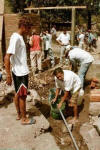 At the worksite, Marvin immediately climbs up to help build the lavandero roof. I help Patty and Wahana and Carolyn
dig a post hole for the fence around the lavandero, but we’re stymied by a monster rock smack dab in the middle of our hole, and it sincerely
doesn’t want to be extracted. After a valiant but futile effort to budge the rock, we drift on to other tasks.
I join the digging of mud out from around the “faucet”, so we can pour a concrete base. About mid-morning, I take a break and follow Ceasar and
Fred and two village men who want to show us how the river changed course during Hurricane Mitch.
We also see their gardens, and numerous trees and plants native to their area. At the river, several women are doing laundry, pounding and
rubbing the clothes industriously against the large rocks. Another young woman is bathing herself and washing her hair.
This new lavandero will provide a better and more sanitary facility for washing.
At the worksite, Marvin immediately climbs up to help build the lavandero roof. I help Patty and Wahana and Carolyn
dig a post hole for the fence around the lavandero, but we’re stymied by a monster rock smack dab in the middle of our hole, and it sincerely
doesn’t want to be extracted. After a valiant but futile effort to budge the rock, we drift on to other tasks.
I join the digging of mud out from around the “faucet”, so we can pour a concrete base. About mid-morning, I take a break and follow Ceasar and
Fred and two village men who want to show us how the river changed course during Hurricane Mitch.
We also see their gardens, and numerous trees and plants native to their area. At the river, several women are doing laundry, pounding and
rubbing the clothes industriously against the large rocks. Another young woman is bathing herself and washing her hair.
This new lavandero will provide a better and more sanitary facility for washing.
After a lunch of rice, beans, platano, cassava and scrambled eggs at the house in Salale, our group mills around waiting for the various celebration activities to get organized. While we’re waiting, we notice the policemen coming up the road from the river, with a man who is obviously a prisoner in tow. They’ve found Carlos’ brother, and have him in custody! They considerately scurry him around behind several houses and lead him out of town a back way, so as not to disturb the celebratory preparations. (Later, they’ll take him back to El Sauce in one of our trucks.)
While we ate lunch, many of the children must have bathed and put on their party clothes, because they now have fresh, clean clothes and neatly combed hair. People begin arriving from everywhere – people we’ve never seen before, and the village swells to twice its normal size. Jeff says such a celebration as this is plenty of reason for members of many surrounding villages to join in the festivities.
We’re all gathered in the dusty area of the central “plaza”, sitting on rock piles or leftover stacks of brick, leaning against the few trees, or just standing. Jim from New York has brought a Polaroid camera and is taking pictures of the villagers. They are swarming around him and pleading to be the subject of his next photo. Those who have been so lucky to have their picture taken already are either showing it off proudly to dozens of curious onlookers, or cradling it carefully, possessively in their hands. Jim is clearly the most popular guy in Salale at this moment.
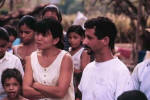
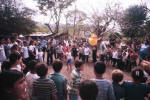 And finally we’re ready to begin. There is a small band of musicians who warm us up with a few songs, then
several speeches from the villagers and from Jeff, and Jim from Maine, whom we’ve chosen to speak for our group. Then, there
are more songs, and finally a piñata for the kids. The breaking of the piñata turns into a frenzied free-for-all, with 75
or so children vying excitedly for the few pieces of released candy. To mitigate the carnage, Jeff and Aileen have provided several of our
group members with additional bags of candy, and, as the children realize there are other candy sources, they start mobbing these guys too.
It’s a messy and raucous process, but there’s not a spare piece of candy left when it’s all over.
And finally we’re ready to begin. There is a small band of musicians who warm us up with a few songs, then
several speeches from the villagers and from Jeff, and Jim from Maine, whom we’ve chosen to speak for our group. Then, there
are more songs, and finally a piñata for the kids. The breaking of the piñata turns into a frenzied free-for-all, with 75
or so children vying excitedly for the few pieces of released candy. To mitigate the carnage, Jeff and Aileen have provided several of our
group members with additional bags of candy, and, as the children realize there are other candy sources, they start mobbing these guys too.
It’s a messy and raucous process, but there’s not a spare piece of candy left when it’s all over.
We say our final goodbyes to our Salale friends, cast a last look at the almost-finished lavandero, and climb on the truck for our last trip back to El Sauce, waving and shouting “adios” till the truck turns the final corner and the town disappears.
It is an evening of mixed sadness and relief. We’ve accomplished the building project we came to do, but being in the community of Salale has affected all of us in various ways. Over the past few days, our group has talked about which of us would choose to do this again, and about half of us would not. It is not the commitment to doing such community self-help projects that would deter some of us; it’s the heat, dust, harshness of conditions and various medical problems that have all taken their toll. Marvin and I feel lucky to have stayed reasonably healthy, and we’re among those who say we would do it again.
Once you’ve left the comfort of your own world and looked into the faces of people who have nothing, held their hands in yours, worked side by side with them, seen and experienced their minimal standard of living – how can you not do something? When you have experienced a world whose inhabitants don’t live as comfortably as our dogs, how can you take a hot shower, open a refrigerator door, drive a car, shop in a grocery store, or do any of a thousand other everyday tasks without remembering those who not only have no showers, refrigerators, cars or grocery stores – they have no water, electricity, and sometimes no food or clothes. It’s so easy to take for granted the riches and opportunities available to us in the U.S. And like Celia said – we in the U. S. use far more than our own share of resources, and we owe it to the rest of the world to give something back.
March 21, 2001
The thin gray light of morning seeps through the window around 5:00 am, the doves are softly cooing, the rooster announces his presence, and there are bustling noises in the courtyard where breakfast is being prepared. After a breakfast of fruit cocktail and lemon muffins, we exchange goodbyes with our hosts at Hotel Casa Blanca, and climb aboard the bus for a 4 ½ hour ride. We travel the same dusty road as before, only this time the rain has dampened things considerably.
The work part of our trip is over, and we’re tourists now. Our destination is Granada, a resort town on the shores of Lake Nicaragua. After the first hour or so of dirt road, most of the rest of the trip is on heavily patched, occasionally potholed, paved 2 or 1 ½ lane road. We notice a lazy plume of smoke escaping from Mumo-Tumbo volcano this morning, rising in the distance over the barren fields. We pass through several busy towns – Sebaco, Ciudad Del Rio, Masaya, and finally rumble into the paved stone streets of Granada.
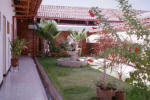 Our hotel, El Hospedadje Italiano, is centrally located downtown very near the main plaza, and is simple but attractive,
with a large high-ceilinged lobby complete with a colorful mural on one long wall, a narrow grassy courtyard with a few flowers and our rooms sprouting
off on each side. The rooms are simple, bigger than Casa Blanca and even have a table and a wardrobe. And that’s
not all – each room has an air conditioner, and there is a working TV in the lobby! (We still can’t drink the
water, and must remember to put the toilet paper in the trash can, but hey!)
Our hotel, El Hospedadje Italiano, is centrally located downtown very near the main plaza, and is simple but attractive,
with a large high-ceilinged lobby complete with a colorful mural on one long wall, a narrow grassy courtyard with a few flowers and our rooms sprouting
off on each side. The rooms are simple, bigger than Casa Blanca and even have a table and a wardrobe. And that’s
not all – each room has an air conditioner, and there is a working TV in the lobby! (We still can’t drink the
water, and must remember to put the toilet paper in the trash can, but hey!)
The owner of the hotel is Italian, and doesn’t speak English. But he’s posted signs in English in each of the rooms to welcome English-speaking visitors and advise them of the “house rules”. In part, the sign says:
El Italiano Lodge give you a warm welcome and thanks for your preference, hopping your stanza on our hotel would be very pleasent and confort.... If you’ll abandon the hotel on early moon, you should cancel your bill one day before on reception.
After lunch at a restaurant just a few doors away, we walk to the Convento de San Francisco, located in a l6th century monastery. It is a delightful little museum, with a room of Primitive style paintings by Nicaraguan artists, another of large stone carvings from nearby Lake Nicaragua, a display of Carlos Martinez Reyes (a famous Nicaraguan poet) memorabilia, some petroglyphs and other anthropological displays. Afterwards, our group members scatter on our own to various sections of town, or in some cases back to the hotel to rest. Marvin and I wander down to the shores of Lake Nicaragua, so huge it has ocean-like waves, and we stroll along a park like section of the lake.
We gather for dinner at an Italian restaurant – comfortable and intimate, and quite classy. Tonight we get to order off the menu, and the choices are mouthwatering. The food is quite good, but the service is slow, they only serve a few of us at a time, then wait 20 minutes or more before the next group gets served. Jim from New York has to wait almost 2 hours for his entrée, and some of our group have drifted back to the hotel and off to bed before he is served.
March 22, 2001
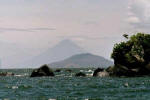
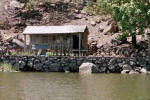 This morning we pile into the truck for a short ride to a chartered boat, which takes us around the islands, Las Isletas, in Lake Nicaragua. The
boat is an old, wooden one, painted blue and white, with a shaded roof. We sit on wooden benches against the sides, facing each other.
For several hours, we weave in and out of the small, rocky islands, viewing small huts, nicer houses, even an elementary school in session on one of
the larger islands. Almost every island that can be is inhabited. It is a warm, sunny and carefree morning, and it is pleasant, peaceful
and calm to be scooting in and around the islands. Jeff points out a few of the islands that are for sale – one for $15,000, one for $45,000.
This morning we pile into the truck for a short ride to a chartered boat, which takes us around the islands, Las Isletas, in Lake Nicaragua. The
boat is an old, wooden one, painted blue and white, with a shaded roof. We sit on wooden benches against the sides, facing each other.
For several hours, we weave in and out of the small, rocky islands, viewing small huts, nicer houses, even an elementary school in session on one of
the larger islands. Almost every island that can be is inhabited. It is a warm, sunny and carefree morning, and it is pleasant, peaceful
and calm to be scooting in and around the islands. Jeff points out a few of the islands that are for sale – one for $15,000, one for $45,000.
For lunch we stop at an island no more than a half acre in size. One family lives here and has built a huge, thatched roof, open shelter with tables as a restaurant. We have a delightful lunch outdoors, of rice, beans, French fries, platano and chicken or fish for the meat-eaters.
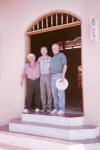 Back at the hotel by early afternoon, we find the water is off in the whole city. It is still brutally hot, and we’d like to shower off the morning’s
sweat and dust, but we head out to explore the town and maybe search for a few souvenirs. Marvin and I come across
a supermarket, and wander through its several aisles, with tired, wilted vegetables piled on an unrefrigerated counter, and assorted canned goods and dry
goods throughout. We later meet up with a few fellow group members at a souvenir shop, but only look and don’t buy. Back at the hotel, they’ve
revised the estimate of when the city will have water, and it’s not for several more hours.
Back at the hotel by early afternoon, we find the water is off in the whole city. It is still brutally hot, and we’d like to shower off the morning’s
sweat and dust, but we head out to explore the town and maybe search for a few souvenirs. Marvin and I come across
a supermarket, and wander through its several aisles, with tired, wilted vegetables piled on an unrefrigerated counter, and assorted canned goods and dry
goods throughout. We later meet up with a few fellow group members at a souvenir shop, but only look and don’t buy. Back at the hotel, they’ve
revised the estimate of when the city will have water, and it’s not for several more hours.
We go as a group to dinner at a delightful Spanish restaurant – decorated with stucco walls and dark wooden beams, and with heavy, ornate wood furniture. The food is fantastic – a spaghetti with cream sauce and mushrooms for me, and a beef filet with rum sauce for Marvin. When we arrive back at the hotel around 9:00, there is finally water!
March 23, 1001
We’re headed back to Managua today, but have several tourist stops on the way. Jeff and Aileen take us to a wonderful artisan’s market, nestled in the city of Granada, and our group splurges on lots of trinkets, mementos and gifts for others. Wahana even buys a rocking chair that is carefully wrapped to go on the plane.
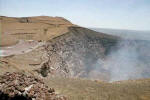 Then it is a short ride to Masaya Volcano National Park, where we climb to a high point over the barely smoldering volcano, and view the barren
crater and angular rim amid the strong smell of sulfur. The lava flows are clearly visible for miles around, even though this volcano last
erupted in the mid-1800s. After a picnic lunch, we wander around the Visitor’s Center, learning some of the history of the volcano and the area.
Then it is a short ride to Masaya Volcano National Park, where we climb to a high point over the barely smoldering volcano, and view the barren
crater and angular rim amid the strong smell of sulfur. The lava flows are clearly visible for miles around, even though this volcano last
erupted in the mid-1800s. After a picnic lunch, we wander around the Visitor’s Center, learning some of the history of the volcano and the area.
Another hour or so on the bus, and we reach Managua, the capital of Nicaragua, with over 1,500,000 inhabitants. It is a bustling, hot, noisy, city – an unwelcome, hectic intrusion into the pace we’ve been experiencing. The earthquake of 1972 nearly destroyed Managua, and many of the buildings here now are less than 30 years old. We stop at the beautiful national museum, an older building that was damaged but not destroyed during the quake, and have an interesting tour, including paintings and sketches, archaeological displays, murals, and geography/flora/fauna. Catty corner from the museum is the national cathedral which was so badly damaged in the quake that it is closed for repairs. But we wander around the outer perimeter to marvel at its architecture.
And then, finally, we arrive back at the Maria La Gorda hotel in Managua, and we fall, tired and zombie-like, into the same rooms we had the night we first arrived, two long weeks ago. Tomorrow we will journey for the last time in the back of the pick-up truck to the airport, climb aboard the plane to Miami, then head our separate ways back to our home cities.
Unlike most of the other group members, I am not yet ready to leave. Much as I have fantasized about the comforts left behind, it is too soon to return to them. I’m just starting to get the hang of living here – being the gringa who doesn’t understand what anyonn is saying, being perpetually hot and dusty, remembering almost consistently not to throw toilet paper in the toilet, forever eating rice and beans, waking in the coolness of dawn to the symphony of sounds as the town awakens. (On the other hand, a pizza sure sounds tempting, and a glass of ice cold water would really hit the spot.) Tomorrow, as originally planned, I’ll trade in my ticket for an airplane ride to that other solar system. But I’ll carry in my heart the helping hands, the smiles, the dreams of the people of Salale for a better way to do things. And some day in the near future, I’ll return to build another lavandero.
